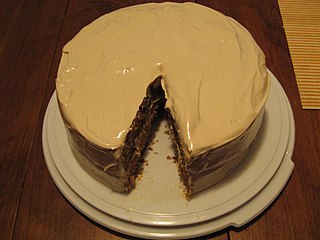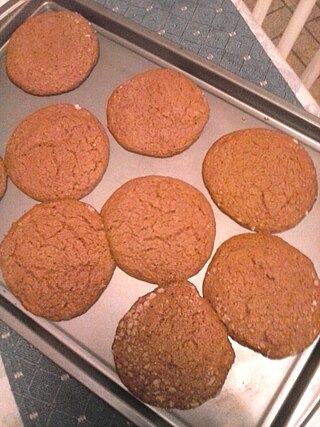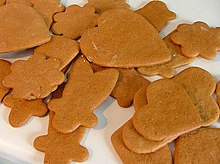
A cookie or biscuit is a baked snack or dessert that is typically small, flat, and sweet. It usually contains flour, sugar, egg, and some type of oil, fat, or butter. It may include other ingredients such as raisins, oats, chocolate chips, or nuts.

Dessert is a course that concludes a meal. The course consists of sweet foods, such as cake, biscuit, ice cream and possibly a beverage such as dessert wine and liqueur. Some cultures sweeten foods that are more commonly savory to create desserts. In some parts of the world there is no tradition of a dessert course to conclude a meal.

A biscuit, in most English speaking countries, is a flour-based baked and shaped food item. Biscuits are typically hard, flat, and unleavened. They are usually sweet and may be made with sugar, chocolate, icing, jam, ginger, or cinnamon. They can also be savoury, similar to crackers. Types of biscuit include sandwich biscuits, digestive biscuits, ginger biscuits, shortbread biscuits, chocolate chip cookies, chocolate-coated marshmallow treats, Anzac biscuits, biscotti, and speculaas.

Lebkuchen, Honigkuchen or Pfefferkuchen are honey-sweetened German cakes, moulded cookies or bar cookies that have become part of Germany's Christmas traditions. They are similar to gingerbread.

Gingerbread refers to a broad category of baked goods, typically flavored with ginger, cloves, nutmeg, and cinnamon and sweetened with honey, sugar, or molasses. Gingerbread foods vary, ranging from a moist loaf cake to forms nearly as crisp as a ginger snap.

Dutch cuisine is formed from the cooking traditions and practices of the Netherlands. The country's cuisine is shaped by its location on the fertile Rhine–Meuse–Scheldt delta on the European Plain bordering the North Sea, giving rise to fishing, farming, and overseas trade. Due to the availability of water and flat grassland, the Dutch diet contains many dairy products such as cheese and butter, and is relatively high in carbohydrates and fat.

A gingerbread house is a novelty confectionery shaped like a building that is made of cookie dough, cut and baked into appropriate components like walls and roofing. The usual base material is crisp gingerbread, hence the name. Another type of model-making with gingerbread uses a boiled dough that can be moulded like clay to form edible statuettes or other decorations. These houses, covered with a variety of candies and icing, are popular Christmas decorations.

Pennsylvania Dutch cuisine is the typical and traditional fare of the Pennsylvania Dutch. According to one writer, "If you had to make a short list of regions in the United States where regional food is actually consumed on a daily basis, the land of the Pennsylvania Dutch—in and around Lancaster County, Pennsylvania—would be at or near the top of that list," mainly because the area is a cultural enclave of Pennsylvania Dutch culture.

Spice cake is a type of cake that is traditionally flavored with a mixture of spices. The cake can be prepared in many varieties. Predominant flavorings include spices such as cinnamon, cloves, allspice, ginger, and nutmeg.

Iraqi cuisine is a Middle Eastern cuisine that has its origins in the ancient Near East culture of the fertile crescent. Tablets found in ancient ruins in Iraq show recipes prepared in the temples during religious festivals—the first cookbooks in the world. Ancient Mesopotamia was home to a sophisticated and highly advanced civilization, in all fields of knowledge, including the culinary arts.

Christmas cookies or Christmas biscuits are traditionally sugar cookies or biscuits cut into various shapes related to Christmas.

An ontbijtkoek, peperkoek or kruidkoek is a Dutch and Flemish spiced cake. Rye and dark brown basterdsuiker are its most important ingredient, coloring the cake light brown. It is often spiced with cloves, cinnamon, ginger, succade and nutmeg. Several parts of the Netherlands have their own local recipe, of which the most famous is oudewijvenkoek, which is mostly eaten in the northern regions, and is flavored with aniseed. Ontbijtkoek is traditionally served at breakfast with a thick layer of butter on top, as a replacement for bread, however, due to its sweet taste it is also served as a snack. It is best eaten the day after it is baked, but has a shelve life of several weeks at room temperatures, without it spoiling, due to the pH, sugar content and used spices.

Pfeffernüsse are small spice cookies, popular as a holiday treat with Germans and ethnic Mennonites in North America. Similar cookies are made in Denmark, and The Netherlands, as well. They are called Pfeffernüsse in German, pepernoten in Dutch, päpanät in Plautdietsch, pfeffernusse or peppernuts in English, and pebernødder in Danish.

A Cornish fairing is a type of traditional ginger biscuit commonly found in Cornwall, England, United Kingdom. "Fairing" was originally a term for an edible treat sold at fairs around the country, though over time the name has become associated with ginger biscuits or gingerbread, which were given as a treat to children or by men to their sweethearts. In Cornwall, fairings contained ginger and became famous around the country when a Cornish manufacturer started selling them by mail order in 1886. The same manufacturer still makes them and the company has recently teamed up with celebrity chef Rick Stein to make biscuits.

Mizrahi Jewish cuisine is an assortment of cooking traditions that developed among the Jews of the Middle East, North Africa, Asia, and Arab countries. Mizrahi Jews have also been known as Oriental Jews.

Omani cuisine is part of the Khaleeji cuisine and is influenced by Arab, Pakistani cuisine, Iranian, Indian, Asian, Eastern Mediterranean, and African cuisine, reflecting Oman's position as a vast trading empire at the intersection of traditional spice trade routes. Dishes are often based on chicken, fish, and lamb, as well as the staple of rice. Most Omani dishes tend to contain a rich mixture of spices, herbs, and marinades. Omani cuisine differs from other cuisines in the Arabian peninsula, as it is less spicy and seldom served warm.

The Joe Frogger is a type of cookie that has been popular in New England since the late 18th century. It is flavored with molasses, rum, and spices and has a soft, chewy center. Because the cookies kept well they could be taken on long sea voyages, and so became popular with fishermen and sailors. The original cookies were the size of pancakes and were cooked in an iron skillet; those made today are typically smaller, and baked in an oven.


















